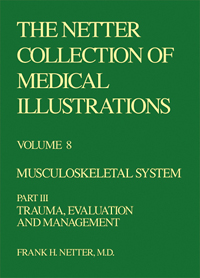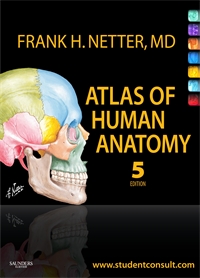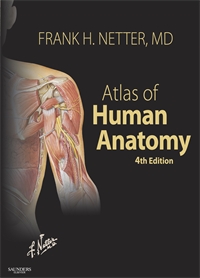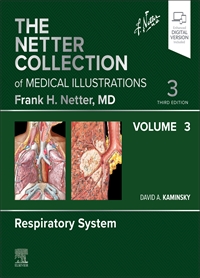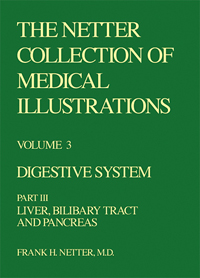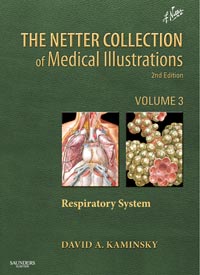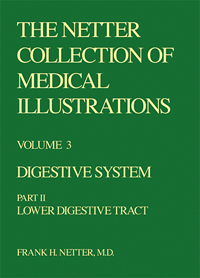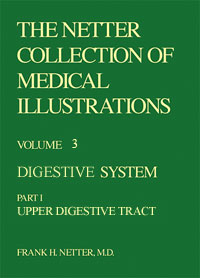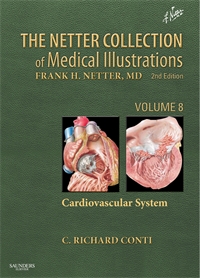Collection of Medical Illustrations, Musculoskeletal System - Volume 8, Part 3
Author: Frank H. Netter, MD
ISBN: 9780914168799
- Page 3: Closed Soft Tissue Injuries
- Page 6: Excision of Deep Pressure Ulcer
- Page 49: Biomechanic Considerations in Fracture of Forearm Bones
- Page 50: Bier Block Anesthesia
- Page 51: Fracture of Both Forearm Bones
- Page 52: Fracture of Shaft of Radius
- Page 53: Fracture of Shaft of Ulna
- Page 54: Extension-Compression Fracture of Distal Radius (Colles Fracture)
- Page 55: Closed Reduction and Plaster Cast Immobilization of Colles Fracture
- Page 56: Pin Fixation and Plaster Cast Immobilization of Comminuted Colles Fracture
- Page 57: Flexion-Compression Fracture of Distal Radius (Smith Fracture)
- Page 58: Fracture of Articular Margin of Distal Radius and of Styloid Process of Radius
- Page 59: Dislocation of Carpus
- Page 60: Dislocation of Carpus, Fracture of Hamulus (Hook) of Hamate
- Page 61: Fracture of Scaphoid
- Page 62: Fracture of Scaphoid
- Page 63: Injury to Fingers
- Page 64: Fracture of Proximal and Middle Phalanges
- Page 65: Management of Fracture of Proximal and Middle Phalanges
- Page 66: Special Problems in Fracture of Middle and Proximal Phalanges
- Page 67: Dislocation of Proximal Interphalangeal Joint
- Page 68: Fracture of Metacarpals
- Page 69: Fracture of Base of Metacarpal of Thumb
- Page 70: Thumb Injury Other Than Fracture
- Page 71: Common Causes of Cervical Spine Injury
- Page 72: Sensory Impairment Related to Level of Spinal Cord Injury
- Page 73: Motor Impairment Related to Level of Spinal Cord Injury
- Page 74: Radiographic Examination of Cervical Spine
- Page 76: Subluxation and Ligamentous Instability of Cervical Spine
- Page 77: Three-Column Concept of Spinal Stability; Burst Fracture
- Page 78: Fracture and Dislocation of Cervical Vertebrae
- Page 79: Stable Fracture of Thoracolumbar Spine
- Page 80: Unstable Fracture of Thoracolumbar Spine
- Page 81: Fracture of Pelvis Without Disruption of Pelvic Ring
- Page 82: Fracture of All Four Pubic Rami , Lateral Compression Injury
- Page 83: Anteroposterior Compression Fracture of Pelvis (Open Book Fracture)
- Page 84: Vertical Shear Fracture (Malgaigne Fracture)
- Page 85: Vascular and Visceral Trauma in Fracture of Pelvis
- Page 86: Fracture of Acetabulum
- Page 87: Fracture of Acetabulum
- Page 88: Posterior Dislocation of Hip
- Page 89: Anterior Dislocation of Hip, Obturator Type
- Page 90: Dislocation of Hip with Fracture of Femoral Head
- Page 91: Intracapsular Fracture of Femoral Neck
- Page 92: Intertrochanteric Fracture of Femur
- Page 93: Subtrochanteric Fracture of Femur
- Page 94: Fracture of Shaft of Femur
- Page 95: Fracture of Distal Femur
- Page 96: Arthrocentesis of Knee Joint
- Page 97: Tears of Meniscus
- Page 98: Fracture of Patella
- Page 99: Disruption of Quadriceps Femoris Tendon or Patellar Ligament
- Page 100: Subluxation and Dislocation of Patella
- Page 101: Sprains of Knee Ligaments
- Page 102: Rupture of Anterior Cruciate Ligament
- Page 103: Rupture of Anterior Cruciate Ligament
- Page 104: Rupture of Anterior Cruciate Ligament
- Page 105: Rupture of Posterior Cruciate Ligament
- Page 106: Dislocation of Knee Joint
- Page 107: Fracture of Proximal Tibia Involving Articular Surface
- Page 108: Fracture of Shaft of Tibia
- Page 109: Rotational Fracture of Ankle Mortise
- Page 110: Repair of Fracture of Malleolus
- Page 111: Vertical Compression Fracture of Ankle (Pilon Fracture)
- Page 112: Fracture of Talus
- Page 113: Fracture of Talus
- Page 114: Dislocation of Subtalar Joint and Talus
- Page 115: Extraarticular Fracture of Calcaneus
- Page 116: Intraarticular Fracture of Calcaneus
- Page 117: Injury to Midtarsal (Chopart) Joint Complex
- Page 118: Injury to Metatarsals and Phalanges
- Page 7: Classification of Burns
- Page 8: Causes and Clinical Types of Burns
- Page 9: Escharotomy for Burns
- Page 10: Prevention of Infection in Burn Wounds
- Page 11: Metabolic and Systemic Effects of Burns
- Page 12: Excision and Grafting for Burns
- Page 119: Microsurgical Instrumentation for Replantation
- Page 120: Debridement, Incisions, and Repair of Bone in Replantation of Digit
- Page 121: Repair of Tendon
- Page 122: Repair of Blood Vessels and Nerves
- Page 123: Postoperative Dressing and Monitoring of Blood Flow
- Page 124: Replantation of Avulsed Thumb
- Page 125: Replantation of Forearm
- Page 126: Venous Flap After Replantation Thumb, Scapular Flap After Replantation Forearm
- Page 127: Lateral Arm Flap for Defect of Thumb Web
- Page 128: Transfer of Great Toe to Thumb
- Page 129: Incomplete Fracture in Children
- Page 130: Injury to Growth Plate (Salter-Harris Classification, Rang Modification)
- Page 131: Fracture of Clavicle in Children, Fracture of Proximal Humerus in Children
- Page 132: Supracondylar Fracture of Humerus in Children
- Page 133: Elbow Injury in Children
- Page 134: Fracture of Forearm Bones in Children
- Page 135: Fracture of Femur in Children
- Page 136: Fracture of Tibia in Children
- Page 137: Fracture in Abused Children
- Page 138: Stress Fracture
- Page 139: Stress Fracture
- Page 140: Pathologic Fracture
- Page 141: Pathologic Fracture
- Page 142: Neurovascular Complications of Fractures
- Page 143: Adult Respiratory Distress Syndrome (Fat Embolism Syndrome)
- Page 144: Classification of Open Fractures, Open Injury with High Risk for Infection
- Page 145: Surgical Management of Open Fractures
- Page 146: Gas Gangrene
- Page 147: Implant Failure
- Page 148: Malunion of Fracture
- Page 149: Growth Deformity After Fracture
- Page 150: Posttraumatic Osteoarthritis
- Page 151: Osteonecrosis After Fracture
- Page 152: Joint Stiffness After Fracture
- Page 153: Reflex Sympathetic Dystrophy
- Page 154: Nonunion of Fracture
- Page 155: Surgical Management of Nonunion
- Page 156: Experimental Electric Stimulation of Bone Growth
- Page 157: Pulsed Inductive Coupling Method of Electric Stimulation of Bone Growth
- Page 13: Etiology of Compartment Syndrome
- Page 14: Pathophysiology of Compartment and Crush Syndromes
- Page 15: Acute Anterior Compartment Syndrome
- Page 16: Measurement of Intracompartmental Pressure
- Page 17: Incisions for Compartment Syndrome of Forearm and Hand
- Page 18: Incisions for Compartment Syndrome of Leg
- Page 19: Healing of Incised, Sutured Skin Wound
- Page 20: Healing of Excised Skin Wound
- Page 21: Types of Joint Injury
- Page 22: Classification of Fracture
- Page 23: Types of Displacement
- Page 24: Types of Fracture
- Page 25: Healing of Fracture
- Page 26: Primary Union
- Page 27: Factors That Promote or Delay Bone Healing
- Page 28: General Principles of Prehospital Care
- Page 29: Prehospital Care of Injury to Shoulder, Arm, and Elbow
- Page 30: Prehospital Care of Fracture of Forearm Bones
- Page 31: Prehospital Care of Suspected Spine Injury
- Page 32: Prehospital Care of Fracture of Pelvis
- Page 33: Prehospital Care of Fracture of Hip
- Page 34: Prehospital Care of Fracture of Lower Limb
- Page 35: Fracture of Clavicle and Scapula
- Page 36: Dislocation of Acromioclavicular or Sternoclavicular Joint
- Page 37: Anterior Dislocation of Glenohumeral Joint
- Page 38: Reduction of Anterior Dislocation of Glenohumeral Joint
- Page 39: Posterior Dislocation of Glenohumeral Joint
- Page 40: Fracture of Proximal Humerus
- Page 41: Exercises for Fracture of Proximal Humerus
- Page 42: Fracture of Shaft of Humerus
- Page 43: Dislocation of Elbow Joint
- Page 44: Reduction of Dislocation of Elbow Joint
- Page 45: Fracture of Head and Neck of Radius
- Page 46: Supracondylar Fracture of Humerus
- Page 47: Fracture of Condyle, Epicondyle, Capitulum, and Olecranon
- Page 48: Intercondylar (T or Y) Fracture of Elbow Joint
- Page 161: Infected Wounds of Hand and Fingers
- Page 162: Cellulitis and Epidermal Abscess
- Page 163: Tenosynovitis and Infection of Fascial Space
- Page 164: Infection of Deep Compartments of Hand
- Page 165: Lymphangitis
- Page 166: Common Infections of Foot
- Page 167: Deep Infections of Foot
- Page 168: Lesions in Diabetic Foot
- Page 169: Clinical Evaluation of Patient with Diabetic Foot Lesion
- Page 171: Etiology and Prevalence of Hematogenous Osteomyelitis
- Page 172: Pathogenesis Of Hematogenous Osteomyelitis
- Page 173: Clinical Manifestations of Hematogenous Osteomyelitis
- Page 174: Direct (Nonhematogenous) Causes of Osteomyelitis
- Page 175: Direct (Nonhematogenous) Causes of Osteomyelitis
- Page 176: Osteomyelitis After Open Fracture
- Page 177: Recurrent Postoperative Osteomyelitis
- Page 178: Delayed Posttraumatic Osteomyelitis in Diabetic Patient
- Page 181: Amputation of Fingertip
- Page 182: Amputation of Phalanx - (Distal)
- Page 183: Amputation of Finger and Ray
- Page 184: Amputation of Forearm and Hand
- Page 185: Amputation of Upper Arm and Shoulder
- Page 186: Amputation of Foot
- Page 187: Syme Amputation (Wagner Modification)
- Page 188: Below-Knee Amputation
- Page 189: Disarticulation of Knee
- Page 190: Hindquarter Amputation (Hemipelvectomy)
- Page 191: Complications of Amputation
- Page 195: Immobilization
- Page 196: Rehabilitation After Amputation
- Page 197: Prosthetic Rehabilitation After Amputation
- Page 198: Prostheses for Lower Limb
- Page 199: Prostheses for Upper Limb
- Page 200: Positioning in Bed After Stroke
- Page 201: Passive Range-of-Motion Exercises After Stroke
- Page 202: Transfer from Bed to Wheelchair After Stroke
- Page 203: Transfer from Wheelchair to Bed After Stroke
- Page 204: Ambulation After Stroke
